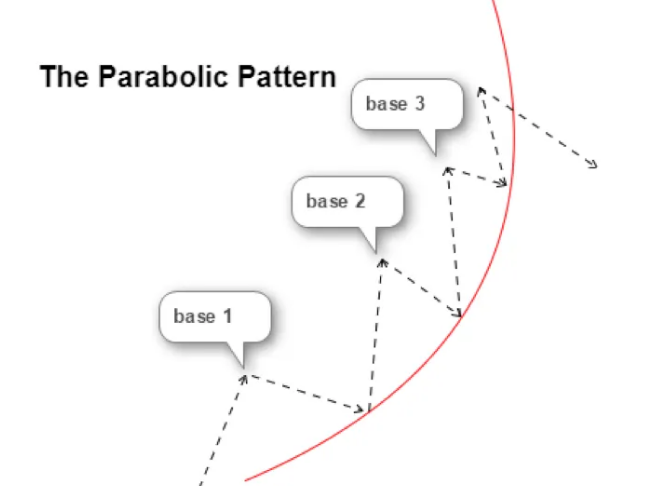
Larissa Barlow
Apr 18, 2022 17:17

The trading level support and resistance notions are, without a doubt, two of the most frequently discussed aspects of technical analysis. Traders use these phrases to refer to price levels on charts that operate as barriers, preventing an asset's price from being pushed in a particular direction.
Although it looks like a simple idea at first, support and resistance can come in numerous forms, and the concept is more challenging to comprehend than it appears.
Support and resistance levels are horizontal price levels that often connect price bar highs to other price bar highs or lows to lows on a price chart, establishing horizontal levels.
When a market's price activity reverses and changes direction, it leaves behind a market peak or trough (swing point). Support and resistance levels can be used to define trading ranges, as illustrated in the chart below, or they can identify swing points in trending markets when the market retraces and leaves behind swing points.
Price frequently respects these support and resistance levels; in other words, they tend to restrain price movement until they are breached.
In layman's terms, a support level is a price level where buyers outnumber sellers. This aggression drives the price upward, away from the rising demand level. There is no balance between supply and demand, with more demand than supply, and hence the price must increase to fulfill the demand. The converse is true for resistance levels.
Traders determine support and resistance levels by examining which price points are consistently defended by buyers or rejected by sellers. Identifying those levels is easier said than done, given that financial markets are rife with randomness.
Occasionally, a stock will pause numerous times at a given price owing to pure randomness rather than a genuine supply/demand mismatch.
Technical analysts use support and resistance levels to indicate price areas on a chart where the odds favor a pause or reversal of a prevailing trend.
Support arises when a downturn is projected to pause due to a concentration of demand.
Where an advance is predicted to stall temporarily due to a concentration of supply, resistance occurs.
Market psychology is critical, as traders and investors recall past events and respond to changing situations to forecast future market movement.
On charts, trendlines and moving averages can identify regions of support and resistance.
Support is the price level at which it is believed that demand is sufficiently strong to keep the price from falling further. According to logic, when the price approaches support and becomes cheaper, buyers become more receptive to buying, and sellers become less receptive to selling. Gradually, the price reaches the support level; demand is expected to outweigh supply, preventing the price from sliding below support.
However, support does not always hold, and a break below it indicates bears that have prevailed over the bulls. A break below support signals an increased propensity to sell and a lack of motive to buy. Support breaks and new lows indicate that sellers' expectations have been decreased, and they are eager to sell at even lower prices. Furthermore, purchasers could not be compelled to purchase until prices fell below support or the previous low. Once support is broken, a new support level at a lower level must be established.
Although support is typically lower than the current price, it is not uncommon for a security to trade at or near support. Establishing accurate support levels is frequently challenging because technical analysis is not an actual science. Additionally, price changes can be erratic, occasionally falling below support. For instance, it would not appear reasonable to regard a support level as broken if the price closes an eighth below the stated support level. As a result, certain traders and investors create support zones.
The price level at selling is believed to be sufficiently strong to prevent the price from increasing further is referred to as resistance. As the price approaches resistance, logic says that sellers become more willing to sell and buyers become less willing to buy. As soon as the price reaches the resistance level, it is expected that supply will outweigh demand, preventing the price from climbing above it.
Resistance is not always resisted; a break over it indicates that the bulls have prevailed over the bears. A break above resistance indicates a renewed readiness to buy and a dearth of selling incentives. Breaking through resistance and setting new highs suggest that consumers' expectations have improved, and they are willing to pay even greater prices. Furthermore, sellers might not be compelled to sell until prices exceed resistance or the prior high. Once resistance is destroyed, a new resistance level at a higher level must be built.
Although resistance levels are often higher than the current price, it is not unusual for a security to trade at or near resistance. Additionally, price moves might be erratic, briefly rising above resistance. Occasionally, it appears illogical to regard a resistance level as broken if the price closes 1/8 above the established resistance level. As a result, certain traders and investors create resistance zones.
Let us illustrate the psychology of support and resistance with a few examples of market players.
To begin, let us imagine that there are purchasers who have been purchasing a stock near a support level. Assume that the level of support is $50. They purchase some stock for $50, and it has since moved up and away from that price to reach $55. The buyers are pleased and wish to purchase further stock at $50, but not at $55. They determine that if the price drops to $50, they will purchase further units. They are generating demand for commodities at the $50 level.
Consider a different group of investors. These are the individuals that remained uncommitted. They considered purchasing the stock when it was $50 but never "pulled the trigger." Now that the stock has reached $55, they regret not purchasing it. They determine that if it reaches $50 again, they will not repeat their error and purchase the stock this time. This results in the creation of potential demand.
The third group purchased the stock below $50; for example, they purchased it for $40. When the stock reached $50, they sold it, only to see it rise to $55. They now wish to re-establish their long positions and repurchase the stock at the same price at which it was sold $50. They have shifted from vendors to buyers. They regret selling it and wish to make amends. This increases demand.
Now, let us shake things up a bit in order to comprehend resistance better. Assume that all of the above players own the stock at $50. Consider becoming one of the owners for $50. The stock rises to $55, and you remain undecided. Now the stock returns to $50, the price you purchased it. What are your emotions? Regret that you did not sell it for $55? Now it is back to $55, and you are encouraged to sell as much as possible this time, as do the other stockholders. The stock is unable to break through $55 and retreats. At least three groups of stockholders are attempting to sell their stock at $55. This establishes a degree of resistance at $55.
These are only a few instances of the numerous possibilities. If you have traded previously, you have likely encountered all of these events and the emotions and psychology. You are not alone in this. Numerous market players are experiencing the same emotions and mental processes as you, which helps explain some of the market psychology underlying support and resistance levels and technical analysis in general.
The majority of seasoned traders can relate stories about how certain price levels prohibit traders from pushing an underlying asset's price in a particular direction. As an example, suppose Jim held a position in stock between March and November, anticipating that the value of the shares would increase.
Assume Jim notes that the price has failed to rise past $39 multiple times over several months, even though it has been dangerously close. Traders would refer to the price level near $39 as a resistance level in this case.
On the other hand, there exist support levels. Prices that act as a floor on a chart are referred to as "support." Preventing an asset's price from falling. As illustrated in the chart below, identifying a level of support can also coincide with a purchasing opportunity, as this is typically the area where market players recognize the value and begin to push prices higher once more.
A constant level prohibits the price of an asset from rising or falling. Although this static barrier is one of the most common types of support/resistance because the prices of financial assets often move upward or downward, it is not uncommon for these price barriers to shift over time. This is why it is critical to understand the principles of trending and trendlines while studying support and resistance.
When a market is heading upward, resistance levels arise as price activity pauses and begins to retrace its steps toward the trendline. This develops as a result of profiteering or near-term insecurity around a specific topic or sector. As a result, the subsequent price action exhibits a "plateau" effect, or a modest decline in stock price, culminating in forming a short-term top.
Many traders will closely monitor the price of a security as it approaches the broader support of the trendline since this has historically been a region that has kept the asset's price from falling significantly lower. For instance, as the chart below for Newmont Mining Corp (NEM) illustrates, a trendline can act as long-term support for an asset. Pay attention to how the trendline supported the price of shares for an extended period in this situation.
Traders search for a sequence of falling peaks and try to connect them with an established trendline when the market declines. When the price approaches the trendline, the majority of traders will look for signs of selling pressure and may consider taking a short position, as this is an area that has historically pushed the price downward.
The support/resistance of an established level, whether by a trendline or another means, is judged to be greater the more times the price has been unable to go beyond it historically. Many technical traders will use their discovered support and resistance levels to determine strategic entry/exit locations. These levels frequently correspond to the prices that have the greatest influence on the direction of an asset. At these levels, most traders are confident in the asset's fundamental value, and volume generally climbs more than usual, making it much more difficult for traders to continue driving the price higher or lower.
Another common feature of support/resistance is that an asset's price may struggle to move above ground, such as $50 or $100 per share. The majority of inexperienced traders prefer to purchase or sell assets when a price is a whole number, as they believe the stock is reasonably valued at these levels. The majority of target prices or stop orders posted by retail investors or large investment banks are round numbers rather than decimal values such as $50.06. At the same price level, it has been a while since we have had this many orders at the price point. These round numbers frequently operate as strong pricing barriers. If all of an investment bank's clients placed sell orders at a proposed target price of $55, it would take an enormous amount of purchases to absorb these sales, creating a level of resistance.
While most technical traders utilize numerous technical indicators, such as moving averages to assist in forecasting future short-term momentum, many are unaware of the instruments' capacity to identify support and resistance levels. As illustrated in the chart below, a moving average is an ever-changing line that smooths out historical price data while also helping the trader pinpoint support and resistance. Take note of how the moving average functions as a support for the asset's price when the trend is upward and as resistance when the trend is downward.
Moving averages can be used in various ways by traders, including anticipating upward gains when price lines cross above a significant moving average or exiting bets when the price falls below a moving average. Whatever method is used to calculate the moving average frequently generates "automatic" support and resistance levels. Most traders will experiment with various periods in their moving averages to determine which one performs best for this particular activity.
Remember how we used the terms "floor" to refer to the point of support and "ceiling" to refer to the point of resistance? Continuing with the house analogy, security is a rubber ball that bounces in a room and hits the floor (support) before rebounding off the ceiling (resistance). A ball bouncing between the floor and the ceiling is analogous to a trading instrument consolidating its price between support and resistance zones.
Now suppose that the ball transforms into a bowling ball in mid-flight. When applied on the way up, this additional force pushes the ball through the resistance level; when applied down, it pushes the ball through the support level. In either case, further power or enthusiasm on the part of the bulls or bears is required to overcome the support and resistance.
When the price seeks to go higher, a previous support level may become a resistance level, and vice versa; when the price momentarily lowers, a resistance level may become a support level.
Price charts enable traders and investors to visually identify areas of support and resistance and provide context for these price levels' significance. More precisely, they consider the following:
The more times a price makes a support or resistance level test, the more meaningful that level becomes. When prices continue to bounce off a support or resistance level, more buyers and sellers become aware of these levels and make trading decisions.
When preceded by sharp rises or dips, support and resistance zones are likely to be more significant. For instance, a rapid, sharp gain or uptrend will attract greater attention and enthusiasm and maybe halted by a more substantial resistance level than a calm, steady advance. The slow progress may not garner as much notice. This is an excellent illustration of how market psychology influences technical indicators.
Support and resistance levels become stronger when there is much activity at a price point. Due to the resiliency of traders and investors, they are likely to return to price levels in the future. When high volume activity happens, and the price falls, a large amount of selling is likely to occur when the price returns to the breakeven mark, as people are significantly more comfortable exiting a trade at the breakeven point than at a loss.
Support and resistance zones take on greater significance when levels are tested consistently over a prolonged period.
Support and resistance levels are impediments to the price moving below or above them. Traders can profit from support and resistance levels in various ways, including trading horizontal S&R levels, trendline, channel S&R levels, Fibonacci retracements, round-number S&R levels, and technical indicators. Nonetheless, always seek further confirmations (such as candlestick patterns) before entering a trade based on S&R levels.

Apr 18, 2022 16:22

Apr 18, 2022 17:25